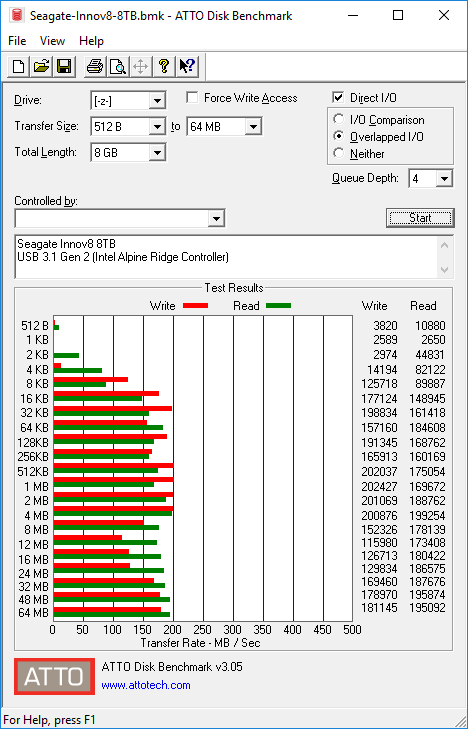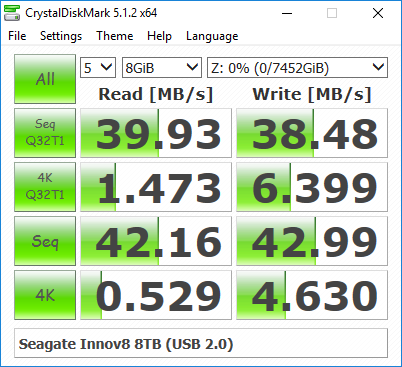Seagate Innov8 8TB Bus-Powered External Hard Drive Review
by Ganesh T S on May 19, 2016 8:30 AM ESTDirect-Attached Storage Benchmarks
The Seagate Innov8 comes pre-formatted in exFAT. We retained the file system along with the contents on it (setup programs for the Seagate Dashboard and a warranty document PDF) for benchmarking purposes. In order to evaluate the DAS aspect of the unit, we utilized the testbed outlined in the table below to test the performance. One of the USB 3.1 ports enabled by the Intel Alpine Ridge controller was used to connect the unit to the system.
| AnandTech DAS Testbed Configuration | |
| Motherboard | GIGABYTE Z170X-UD5 TH ATX |
| CPU | Intel Core i5-6600K |
| Memory | G.Skill Ripjaws 4 F4-2133C15-8GRR 32 GB ( 4x 8GB) DDR4-2133 @ 15-15-15-35 |
| OS Drive | Samsung SM951 MZVPV256 NVMe 256 GB |
| SATA Devices | Corsair Neutron XT SSD 480 GB Intel SSD 730 Series 480 GB |
| Add-on Card | None |
| Chassis | Cooler Master HAF XB EVO |
| PSU | Cooler Master V750 750 W |
| OS | Windows 10 Pro x64 |
| Thanks to Cooler Master, GIGABYTE, G.Skill and Intel for the build components | |
Our testing methodology for DAS units takes into consideration the usual use-case for such devices. The most common usage scenario is transfer of large amounts of photos and videos to and from the unit. The minor usage scenario is importing files directly off the DAS into a multimedia editing program such as Adobe Photoshop. Prior to taking a look at the real-life benchmarks, we first check what ATTO and CrystalDiskMark have to report for the Seagate Innov8. We see numbers around 200 MBps for sequential transfers, correlating well with Seagate's performance claims.
In order to tackle the first real-life use-case, we created three test folders with the following characteristics:
- Photos: 15.6 GB collection of 4320 photos (RAW as well as JPEGs) in 61 sub-folders
- Videos: 16.1 GB collection of 244 videos (MP4 as well as MOVs) in 6 sub-folders
- BR: 10.7 GB Blu-ray folder structure of the IDT Benchmark Blu-ray (the same that we use in our robocopy tests for NAS systems)
| Seagate Innov8 8TB robocopy Benchmarks (MBps) | ||
| Write Bandwidth | Read Bandwidth | |
| Photos | 41.81 | 29.22 |
| Videos | 76.81 | 92.11 |
| Blu-ray Folder | 100.23 | 116.91 |
These numbers show the unpredictable nature of the performance of the drive. It is not only the DRAM cache (that usually delivers predictable changes in performance beyond a certain amount of data), but, also the distributed media cache on the SMR drive that influence the write speeds. Reads are affected quite a bit if they happen to involve data that is currently being subject to 'garbage collection' - i.e, moving from one portion of the drive / cache to a more permanent location in the platters.
For the second use-case, we take advantage of PC Mark 8's storage bench. The storage workload involves games as well as multimedia editing applications. The command line version allows us to cherry-pick storage traces to run on a target drive. We chose the following traces.
- Adobe Photoshop (Light)
- Adobe Photoshop (Heavy)
- Adobe After Effects
- Adobe Illustrator
Usually, PC Mark 8 reports time to complete the trace, but the detailed log report has the read and write bandwidth figures which we present in our performance graphs. Note that the bandwidth number reported in the results don't involve idle time compression. Results might appear low, but that is part of the workload characteristic. This is not the intended use-case for external hard drives, but the results are just presented here for the sake of completeness.
| Seagate Innov8 8TB PCMark8 Storage Benchmarks (MBps) | ||
| Write Bandwidth | Read Bandwidth | |
| Adobe Photoshop (Light) | 73.13 | 3.92 |
| Adobe Photoshop (Heavy) | 94.87 | 5.21 |
| Adobe After Effects | 74.41 | 4.10 |
| Adobe Illustrator | 115.22 | 3.91 |
Seagate explicitly mentions that the Innov8 is not compatible with USB ports delivering less than 7.5W of power. Taking the safe route, they don't advertise compatibility with any Type-A ports. However, we got curious and decided to use a Type-A to Type-C USB 3.1 adapter cable and check with the other USB ports in our DAS testbed.
Surprisingly, even the USB 2.0 ports on the GIGABYTE motherboard in our testbed are able to supply the 7.5W minimum power required by the Innov8.
Our rough benchmarking (CrystalDiskMark only) with the USB 2.0 port shows that sequential transfers have no problems in saturating the USB 2.0 bandwidth.













41 Comments
View All Comments
chekk - Thursday, May 19, 2016 - link
Ganesh, any idea if the firmware used in this version is also present in the latest standard Archive models? I tried out an internal 8TB last year and was impressed until a large sequential write slowed to < 10 MB/s and didn't really recover.ganeshts - Thursday, May 19, 2016 - link
I believe Seagate tunes firmware depending on where the drive is going to end up (i.e., firmware on the external drive models will differ from what is offered for archival purposes - the standalone SATA drives).I will ask Seagate whether it is possible to update the firmware on the CTUs that I received last year. FWIW, the Seagate website says it is not possible to upgrade the firmware on any of the ST8000AS0002 models.
eddieobscurant - Thursday, May 19, 2016 - link
Yes it is. I have 2 archive 8tb from 6 months ago with fw ver AR15 and bought another 2 last week with fw ver AR17, although as ganesh said seagate doesn't provide a way to upgrade the fw to my old ones.I ran a few quick benches (atto, crystal disk mark, etc) between the 2 fw versions without noticing any differences
treecrab - Thursday, May 19, 2016 - link
Ganesh,About large file transfer slowdown: it might be a Windows quirk. I've noticed it on machines with largish (32GB) amount of memory. Basically, when writing several large files, Windows starts to push next file in queue while previous is still being flushed from cache, resulting in disk trashing. It's not very noticeable on a regular harddrive, but on SMR it is going to be bad. Can you repeat that large file writing test but from Linux? Or pull memory out from you windows machine so it can't cache so much?
ganeshts - Thursday, May 19, 2016 - link
It is the same test that works perfectly fine on a large number of other DAS units that I have reviewed [ for example, here: http://www.anandtech.com/show/10208/lacie-porsche-... ] - so, I am quite positive the slowdown has got to do with SMR. Btw, ref. caching - the files are transferred from / transferred to a RAM drive so that the aspect of the source disk speed is negated, and we are testing pure external drive performance.Also, in modern machines, users are definitely going to have large amounts of memory - our testing is as much real-world as it can be :)
treecrab - Thursday, May 19, 2016 - link
Sure, as I said, it's not noticeable (only audible) on regular drives. My point is that the problem is not with SMR alone, but with the way Windows interacts with it. And I'm not disputing test results or they applicability to real world scenarios (although Linux and Mac users might find the drive behaving differently). I'm more interested in finding a good explanation for the phenomenon, hence my cache hypothesis. Other way to check - simply write only one, but humongous file instead of several merely huge ones - If I'm right, there will be no drastic slowdowns (except for usual inner cylinder slump)bananaforscale - Thursday, May 19, 2016 - link
As far as I know it's even more of a problem on Linux.hlmcompany - Thursday, May 19, 2016 - link
My use for bus-powered drives requires that they be portable. Unfortunately, this 3.5" drive is not suited for such a purpose.MrSpadge - Thursday, May 19, 2016 - link
Seagate is not aiming this at replacing every other external drive.adityarjun - Thursday, May 19, 2016 - link
What happens 3 years down the lone when the battery can no longer hold any charge? WIll it be easily replaceable? Will seagate still manufacture these batteries or are they gonna do a Motorola and refuse to repair them? What about 10 years down the line.The battery component seems to be a huge risk.